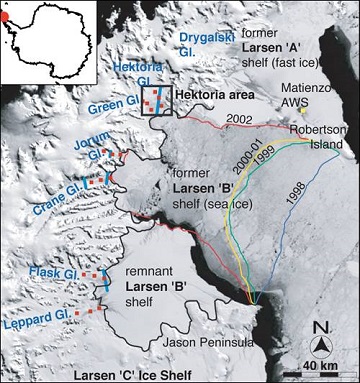380215-vanishing ice.jpg

The collapse of the Larsen B ice shelf. Credit: NASA
Some giant sheets of ice off the coast of Antarctica are disappearing like ice cubes being emptied from a stack of trays in your freezer. The first tray was emptied two decades ago, a second followed a few years later, and a third may go by the end of the decade.
These “trays” are parts of the Larsen Ice Shelf. It reaches into the Weddell Sea from a narrow finger of land that extends toward South America.
The shelf is an extension of thick layers of ice on the Antarctic continent. The weight of the ice causes it to flow toward the sea. As it reaches the coastline, it pushes far out over the sea.
The Larsen shelf is divided into several parts, labeled with the letters of the alphabet. When explorers first reached Antarctica, each segment covered hundreds or thousands of square miles.
Thanks to Earth’s warming climate, though, the northernmost segment of the shelf broke apart and drifted away in 1995. Known as Larsen A, it was the smallest segment, and had been around for only a few thousand years.
Then, in 2002, most of Larsen B disintegrated as well. And a recent study says the remaining part of Larsen B — about 600 square miles of ice — is likely to go by 2020.
Larsen C is showing signs of failure as well. There are cracks at the “roots,” near the shoreline. And it’s getting a lot thinner. So this massive slab of ice — which may have been around for 150,000 years — could disintegrate within the next few decades — one more ice tray emptied by our changing climate.

